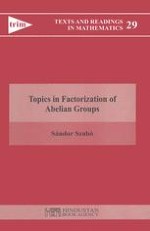2004 | OriginalPaper | Buchkapitel
The Hajós property
verfasst von : Sándor Szabó
Erschienen in: Topics in Factorization of Abelian Groups
Verlag: Hindustan Book Agency
Enthalten in: Professional Book Archive
Aktivieren Sie unsere intelligente Suche, um passende Fachinhalte oder Patente zu finden.
Wählen Sie Textabschnitte aus um mit Künstlicher Intelligenz passenden Patente zu finden. powered by
Markieren Sie Textabschnitte, um KI-gestützt weitere passende Inhalte zu finden. powered by
In Section 1.1 we mentioned that a finite abelian group G possesses the Hajós 2-property if and only if G is a subgroup of a group of type <math display='block'> <mrow> <mtable columnalign='left'> <mtr columnalign='left'> <mtd columnalign='left'> <mrow> <mrow><mo>(</mo> <mrow> <msup> <mi>p</mi> <mi>α</mi> </msup> <mo>,</mo><mi>q</mi> </mrow> <mo>)</mo></mrow><mo>,</mo> </mrow> </mtd> <mtd columnalign='left'> <mrow> <mrow><mo>(</mo> <mrow> <msup> <mi>p</mi> <mn>2</mn> </msup> <mo>,</mo><msup> <mi>q</mi> <mn>2</mn> </msup> </mrow> <mo>)</mo></mrow><mo>,</mo> </mrow> </mtd> <mtd columnalign='left'> <mrow> <mrow><mo>(</mo> <mrow> <msup> <mi>p</mi> <mn>2</mn> </msup> <mo>,</mo><mi>q</mi><mo>,</mo><mi>r</mi> </mrow> <mo>)</mo></mrow><mo>,</mo> </mrow> </mtd> <mtd columnalign='left'> <mrow> <mrow><mo>(</mo> <mrow> <mi>p</mi><mo>,</mo><mi>q</mi><mo>,</mo><mi>r</mi><mo>,</mo><mi>s</mi> </mrow> <mo>)</mo></mrow><mo>,</mo> </mrow> </mtd> </mtr> <mtr columnalign='left'> <mtd columnalign='left'> <mrow> <mrow><mo>(</mo> <mrow> <msup> <mi>p</mi> <mn>3</mn> </msup> <mo>,</mo><mn>2</mn><mo>,</mo><mn>2</mn> </mrow> <mo>)</mo></mrow><mo>,</mo> </mrow> </mtd> <mtd columnalign='left'> <mrow> <mrow><mo>(</mo> <mrow> <msup> <mi>p</mi> <mn>2</mn> </msup> <mo>,</mo><mn>2</mn><mo>,</mo><mn>2</mn><mo>,</mo><mn>2</mn> </mrow> <mo>)</mo></mrow><mo>,</mo> </mrow> </mtd> <mtd columnalign='left'> <mrow> <mrow><mo>(</mo> <mrow> <mi>p</mi><mo>,</mo><msup> <mn>2</mn> <mn>2</mn> </msup> <mo>,</mo><mn>2</mn> </mrow> <mo>)</mo></mrow><mo>,</mo> </mrow> </mtd> <mtd columnalign='left'> <mrow> <mrow><mo>(</mo> <mrow> <mi>p</mi><mo>,</mo><mn>2</mn><mo>,</mo><mn>2</mn><mo>,</mo><mn>2</mn><mo>,</mo><mn>2</mn> </mrow> <mo>)</mo></mrow><mo>,</mo> </mrow> </mtd> </mtr> <mtr columnalign='left'> <mtd columnalign='left'> <mrow> <mrow><mo>(</mo> <mrow> <mi>p</mi><mo>,</mo><mi>q</mi><mo>,</mo><mn>2</mn><mo>,</mo><mn>2</mn> </mrow> <mo>)</mo></mrow><mo>,</mo> </mrow> </mtd> <mtd columnalign='left'> <mrow> <mrow><mo>(</mo> <mrow> <mi>p</mi><mo>,</mo><mn>3</mn><mo>,</mo><mn>3</mn> </mrow> <mo>)</mo></mrow><mo>,</mo> </mrow> </mtd> <mtd columnalign='left'> <mrow> <mrow><mo>(</mo> <mrow> <msup> <mn>3</mn> <mn>3</mn> </msup> <mo>,</mo><mn>3</mn> </mrow> <mo>)</mo></mrow><mo>,</mo> </mrow> </mtd> <mtd columnalign='left'> <mrow> <mrow><mo>(</mo> <mrow> <msup> <mn>2</mn> <mi>α</mi> </msup> <mo>,</mo><mn>2</mn> </mrow> <mo>)</mo></mrow><mo>,</mo> </mrow> </mtd> </mtr> <mtr columnalign='left'> <mtd columnalign='left'> <mrow></mrow> </mtd> <mtd columnalign='left'> <mrow> <mrow><mo>(</mo> <mrow> <msup> <mn>2</mn> <mn>2</mn> </msup> <mo>,</mo><msup> <mn>2</mn> <mn>2</mn> </msup> </mrow> <mo>)</mo></mrow><mo>,</mo> </mrow> </mtd> <mtd columnalign='left'> <mrow> <mrow><mo>(</mo> <mrow> <mi>p</mi><mo>,</mo><mi>p</mi> </mrow> <mo>)</mo></mrow><mo>.</mo> </mrow> </mtd> <mtd columnalign='left'> <mrow></mrow> </mtd> </mtr> </mtable> </mrow> </math>$$\begin{array}{*{20}{l}} {\left( {{p^\alpha },q} \right),}&{\left( {{p^2},{q^2}} \right),}&{\left( {{p^2},q,r} \right),}&{\left( {p,q,r,s} \right),} \\ {\left( {{p^3},2,2} \right),}&{\left( {{p^2},2,2,2} \right),}&{\left( {p,{2^2},2} \right),}&{\left( {p,2,2,2,2} \right),} \\ {\left( {p,q,2,2} \right),}&{\left( {p,3,3} \right),}&{\left( {{3^3},3} \right),}&{\left( {{2^\alpha },2} \right),} \\ {}&{\left( {{2^2},{2^2}} \right),}&{\left( {p,p} \right).}&{} \end{array}$$. Here p, q, r, s are distinct primes, the p = 2 or p = 3 cases are not excluded and α ≥ 3 is an integer.
